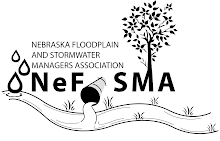If you are an MS4 or a Floodplain Administrator in Nebraska, you should consider using the WQ-COSM tool to get an accurate value of your local water quality rain event.
If you are interested, we can consider running this simulation for a couple communities in Nebraska when we host the NeFSMA Annual Conference on June 23rd, 2011. Send an email to jesse.poore@fhueng.com if you want us to consider running the tool for your community at the conference.
URBAN WATERSHEDS RESEARCH INSTITUTE
To all stormwater management professionals:
The Urban Watersheds Research Institute, with the help and guidance of the Urban Drainage and Flood Control District and the Civil Engineering Department of the University of Colorado Denver, developed new software for the sizing of the Water Quality Capture Volume (WQCV), an essential part of stormwater best management practices (BMPs) that control the volume and rates of runoff.
This software calculates surface runoff using continuous simulation. To do so, it uses continuous 15- and 60-minute rainfall data available from the National Climatologic Data Center. Two runoff options are available, the Rational Method and the modified Horton's Equation, similar to that employed by the EPA SWMM 5.0 model. Runoff is based on the hydrologic properties of the tributary catchment and will work anywhere in the country. The WQCV is calculated using the runoff volumes generated and the user-input drain time for this volume, something the user should know for the BMP being designed.
The model provides the user with a comprehensive list of WQCVs to choose from along with the percent of all runoff volume captured, as well as the percent of the storm events captured in total for each capture volume. In addition, the maximized WQCV (i.e., the point of diminishing returns) is also identified for the user to consider. This information greatly simplifies the sizing and the design of BMPs. Best of all, it is simple to use and BMP design is then based on continuous simulation results using rainfall data collected over long periods of time (i.e., most of the time exceeding 20 years) and not on synthetic design storms.
A document describing what the software does, the software itself, and the user manual may be downloaded and used at no cost from the following three links:
UWRI would appreciate hearing from you if you use it, how it performs and what enhancements or changes you would like to see implemented in the future. E-mail Ben Urbonas your comments at info@urbanwatersheds.org.
Ben Urbonas, PE, D.WRE
President
Urban Watersheds Research Institute







